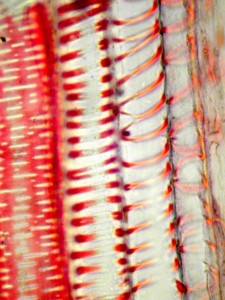Living in Vancouver, mosses, flowers and trees are a common sight, though the structural similarities between these seemingly different plants may come as a surprise. There are currently over 300,000 known species of plants on Earth, each with its own unique characteristics. Despite this incredible amount of diversity, one crucial component that all plants have in common is a molecule known as lignin. It is this molecule that allows a plant to grow upright with a rigid stem so that water can be transported effectively to all of its cells.
Lignin is deposited in specific ringed patterns in cell walls in a process called lignification in order to strengthen the cells. We’ve known that by having this slinky-like coiled design instead of a fixed cylindrical pattern like a drinking straw, the plant cells that deliver water are able to stretch and grow. However, the way that lignin is deposited in this pattern was not well-understood until recently; researchers at UBC have discovered that there are two key laccase enzymes, chemicals that help speed up reactions, that allow this pattern to occur.

A view of the coiled pattern of lignin in cell walls of the water-transporting plant tissues. Each tube is one cell. Source: Leighton Dann on Flickr
In an interview with the lead researcher, Dr. Mathias Schuetz, we learned more about the importance of lignin and how his team made their discovery, as documented in the video below:

At this point, you may be wondering exactly what the connection is between Dr. Schuetz’s research and the emerging applications, such as for the biofuel industry. With the fundamentals of lignification better understood through this research, there is high potential for improving certain industrial processes. For example, since lignin strengthens plant cell walls, it makes working with the other components of the cell wall extremely difficult, so figuring out how to remove (or even decrease) lignification without affecting other properties of plants could be extremely beneficial. As seen in the closing scene of the video, removing lignin from plants will cause them to droop. This means that accessing components like cellulose, a chain of sugars that is useful for industrial purposes, will be much easier.
Dr. Schuetz touches on details of a few implications in the following audio podcast:

In application, decreasing the amount of lignin that goes into cell walls as much as possible without stunting the growth of the plant can provide us with raw plant material that is easier to process. Looking at the big picture, if we can substantially decrease the energy cost of processing this plant material, we can increase the yield of valuable product. This would not be possible without the fundamental understanding of how laccases are involved in lignification.
Matthew Cho, Sunny Sohn, Mikaela Stewart, Dustin Woo
